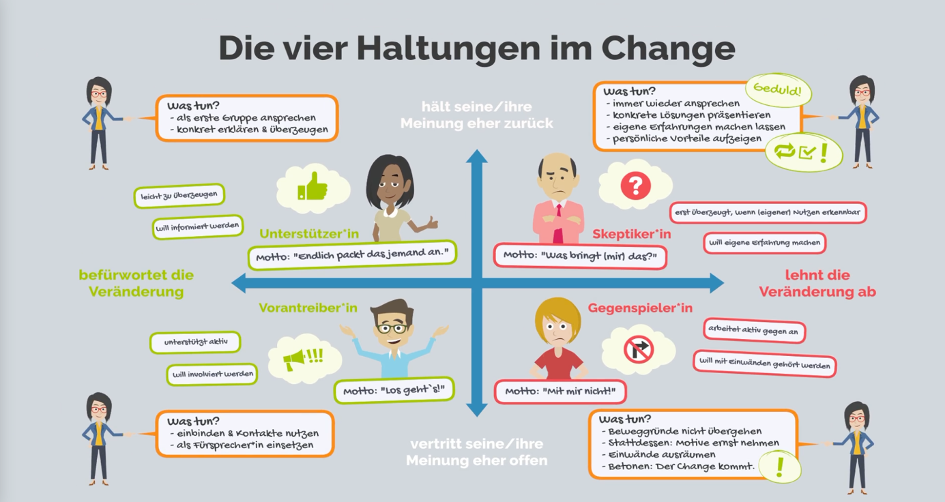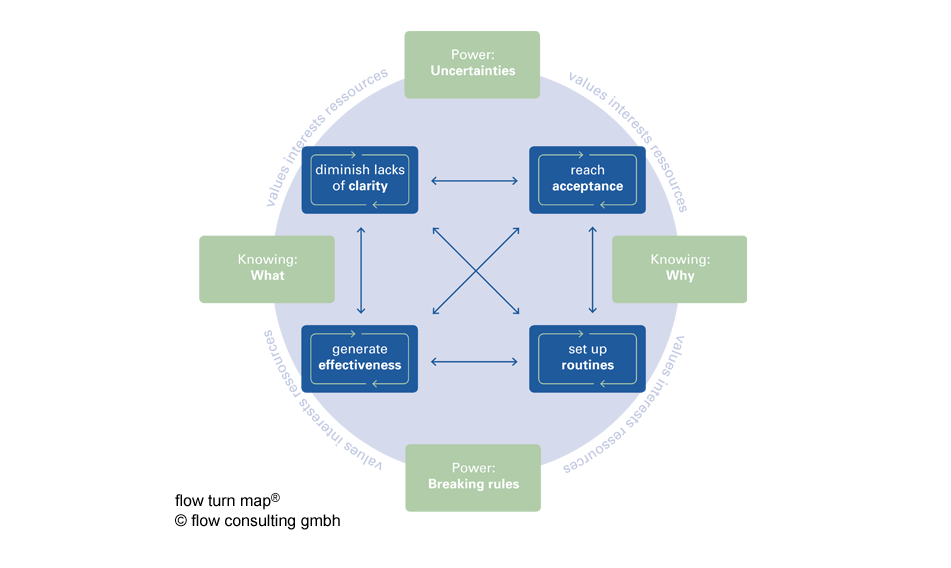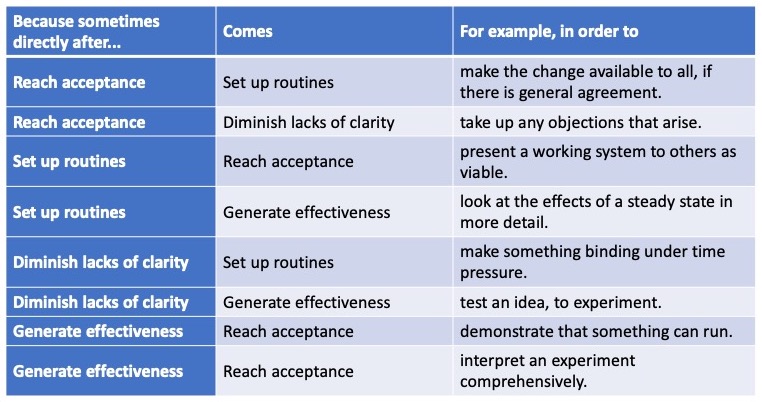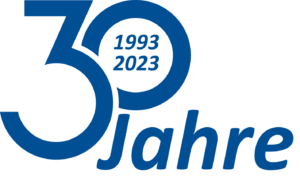Generating effectiveness in change management. Get some ideas here.
We want to achieve something, don’t we?
When something works, we can usually feel, observe or measure it. This can be emotional (“I feel better.”) or rational (“We have achieved a 10% increase.”). In complex change processes in particular, however, the effect of a measure cannot always be recognised immediately. And then the impression often arises that nothing is happening or that the project has stalled.
An example: a manufacturing company realises that the process from research and development to product delivery is too slow. Customers complain about excessively long delivery times and delays. The idea of tackling the issue with a change project and finding solutions quickly finds fellow campaigners.
Of course, motivation is high at the start of the project, but the process analysis takes a long time and the various departments get into long arguments about who is responsible for which faults in the process. And then it is pointed out that they themselves have no influence, that it is due to problems at the suppliers, etc. Then a new solution is discussed. Then a new solution is discussed. The technical interfaces should be reduced, digitalisation and AI should help. However, the development of this solution takes a long time and is fraught with difficulties. The motivation for the project diminishes more and more. The obstacles outweigh the benefits and so more than a year goes by.
Tip for change managers: make successes visible
The impression that nothing has happened is usually deceptive and the first – albeit small – successes are simply not recognised by those involved. So keep an eye on when and how you can make the effectiveness of a project visible. And these can also be other successes than the ones you originally expected. After all, not all complications can be predicted in complex projects. There can always be side effects that come as a surprise during the implementation of a change project. Even prior training and a project group working on the topic using Scrum, for example, cannot foresee all effects.
Making successes visible is worthwhile: when people experience that something is working, that the first steps towards improvement have been taken, then everyone knows that the right path has been taken and is keen to continue. Even if you may have to adjust one or two procedures.
Use the flow turn map
Take a look at our flow turn map for your change project. Where is the biggest pain, the biggest gap? Are some things unclear or is there too little acceptance for the project? Do you need to work on reducing ambiguities, on acceptance or rather on making the first effects visible? With the help of the flow change navigator, you can check whether the topic of “generate effectiveness” is currently the most important lever for your own change project.
These 7 questions will help you to identify the problem with a lack of effectiveness
These questions can help you to find out what needs to be done to generate effectiveness.
– What are possible initial successes – and how do you measure them?
– How can you introduce and support the new programme?
– How do you respond to the additional efforts of employees?
– How do you integrate the people who are not directly involved in the change?
– How do you recognise and manage unexpected events and expectations?
– How do you deploy and control resources?
– How do you deal with uncertainty during initial practical experience?
Method: Morsels instead of chunks
One way to ensure that effectiveness is recognised more quickly is the “morsels instead of chunks” method. And this is more than just a method, it is also an attitude.
For example, when starting a change project: Which initial simple steps can be used to make success tangible? Or in participation: Who can be given the role of trying things out and acting as an important source of impetus and feedback? Of course, the project can also be limited, e.g. the pilot introduction in a single area, a single product or a limited process.
Make successes visible: Build on personal reports
Often only a few people hear about the successes, e.g. during a presentation to the management board or in a discussion in the project group. Record the effects of individual measures and communicate them as widely as possible. For example, through reports from employees at a project conference or meeting. Applied to our example: How have we accelerated the process through the weekly coordination meeting or cleared up misunderstandings or exchanged information with each other better? Or someone reports how he or she was able to reach a new agreement with a supplier – through consistent negotiation and personal contact during a visit to the supplier in Asia. It is important that improvements do not remain abstract, but that personal experiences are added.
Which key figures can you use to demonstrate impact?
When it comes to change, some people only think about the results that can be presented at the end. However, please remember in good time which indicators you can use during the process to show how far you have come in the change process. In our example, these could be process indicators, e.g. the number of disruptions or the duration of a sub-process. Data from customer surveys can also sometimes be helpful. How many complaints were there about late deliveries in relation to the quantity of products delivered? Sometimes your own perception is only characterised by negative individual examples (“He called me and complained”), but this is not always representative. So make sure you have more objective standards.
Conclusion: Three things for a visible effect
- set not only large milestones in a complex change project, but also small, manageable work packages that quickly lead to visible successes. Document this, use good indicators and also communicate the partial successes.
- remember to involve the people affected. Inform them. Listen to what impact the changes have on their day-to-day work. Train the skills of those involved and give them the right to participate in the change project. Anyone who feels that something is happening and doesn’t just hear about it from others will be happy to participate.
- enable small experiments, let people try things out and evaluate the results immediately. You can then make adjustments or integrate good ideas into the overall change project. And you can report on the effects of these experiments.
What effects have you personally felt, seen or measured in the first month of this year? If you have already taken the first small step towards your annual plan – congratulations! Then realise this and celebrate.
I wish you many more positive effects this year.
Best wishes.
Blog part 3 from 8 January 2024
“Diminish lacks of clarity” with Sesame Street? Yes, because there is a connection to iterative change management. “Why is that?” More on this in this part of the blog.
How often have we (in Germany) sung along to the theme of Sesame Street: “…why is that – ask or you won’t know”. Asking questions helps. And it helps to “reduce ambiguity”. It is not for nothing that this topic of change appears in our flow turn map®. This is because, in addition to the three other change topics, it is one that can repeatedly come to light in change processes. In other words, managers should never be sure that everyone involved in a change project has understood everything as it was intended. Or perhaps some of the information was not communicated at all because it was simply forgotten or was labelled as “not so important”.
flow turn map® in practice
Here is an example from our consulting practice on the relevance of the phase “Diminish lacks of clarity”:
The change project starts with a workshop. Here, managers learn from the company management about the background and the necessity of the change. They start working immediately, find relevant topics together, make plans and agree on the next steps. And yet there is a noticeable reluctance among the managers present. Even if, after further explanations of the planned course of the project, one or two slightly confident nods are heard. Despite all efforts, the final round of this first joint kick-off workshop could be labelled “it is clear that little is yet clear”. In the course of further discussions over the following days and weeks, it became clear that many questions remained unanswered, some managers were distracted at times during the workshop and could not really open up to the topics. Only in further events and meetings does it become clearer where the journey should go. Diminishing lacks of clarity requires – as in this case – time, good listening and binding statements, among other things.
7 questions to reduce ambiguity
- By whom and how is the change concept being developed?
- What does the concept for change look like?
- What is the goal of the change?
- Which routines are to be abandoned/changed? Which new ones should be created?
- What framework conditions need to be considered or created?
- How do we plan the resources?
- What effects do we expect the changes to have?
Diagnostic tool for greater clarity: the timeline
Many activities in an organisation have a history and an inner logic. Like a script once written, past events influence the perception and behaviour of the organisation’s members in the present. Some reactions in organisations can only be deciphered against the background of this script. With the diagnostic tool of the timeline, past events and their effects on the organisation are examined and discussed together. Changes can often only succeed if functional and dysfunctional organisational patterns are recognised.
We use this tool, which we will describe in more detail in one of the next blogs, in our consulting practice, for example, to:
- gain an understanding of the current situation from the past,
- better understand worries, fears, needs and reasons for scepticism,
- learn from the past,
- to form hypotheses for change,
- to clarify challenges in the future.
In the change situation described above, working with the timeline brought a great deal of understanding to the management team. And there was almost a sense of relief among those involved because things that had previously been under the carpet could finally be discussed.
How managers ensure greater clarity
We are often asked whether the “reducing ambiguity” phase is ever really over. The question is justified. After all, in the course of change, questions will keep cropping up that managers have long since dealt with. One thing is clear: if the uncertainties about the reason, content, intention and benefits of a change have been reduced, you are definitely on the right track. It is best to pay attention to the following points:
- Collect data and facts with which you can justify the change in a comprehensible manner.
- Explain the intention, content and purpose of the change.
- Think about the attitudes and perceptions of the groups affected.
- Describe the intended benefits for clearly defined groups.
- Analyse existing and required skills and how you can support their development and expansion.
Conclusion: Remain sceptical when everything seems clear
A personal tip: If everything seems crystal clear to you as a manager, be sceptical. Because – and you will certainly be familiar with this from your management practice – discussed means not yet understood, understood means not yet accepted, accepted means not yet implemented… There could hardly be a better way to make this clear than with the help of Grobi (Grover) from Sesame Street. Allow yourself 4 minutes to smile, actually scroll to the minutes from 12:58 to 16:53 – unless you enjoy watching a whole episode of Sesame Street again… Here is the (German) link: Inside or outside? A simple question at first glance – but not for Grobi as a window cleaner.
For the new year, I wish you perspective, patience and clarity. By the way, we are also happy to take on the role of “window cleaner” for you 😉.
Best regards
Blog part 2 from 4 October 2023
How to reach acceptance for your change project
As my colleague Frank Wippermann announced in Part 1 of this blog, it is worthwhile to delve into the individual change topics of the turn map.
And since the order of the 4 change topics “reducing ambiguity”, “achieving acceptance”, “generating effectiveness” and “establishing routines” cannot be fixed in iterative change management, we simply start at the beginning of the alphabet with “achieving acceptance”.
First ask yourself 5 questions
– What is the best way to inform people about the changes?
– Who needs to be involved and when?
– What is the appropriate communication concept?
– Does the original concept have to be supplemented/changed due to unexpected reactions/new perspectives?
– Which existing processes and structures should the change be incorporated into first?

Reach acceptance: Count on these 4 attitudes towards change
It would be so beautiful – almost like in a fairy tale: you as a leader are planning a change project and the enthusiasm is great. Everyone recognises the need for change and wants to get involved immediately to make the change a success.
But in reality, there are almost always at least four different reactions to change. These four “change attitudes” differ in their attitude towards change and in the volume and vehemence with which they express their opinion. The drivers are loudly in favour of the project. Opposed to them are the opponents who openly reject it. These two groups often get a lot of attention. However, there are also the supporters and the sceptics, who are reluctant to express their opinions and cannot be immediately assessed. These two groups are all the more relevant for change to succeed. To know what the quieter ones think, you need to do more than just give a blazing speech.
The drivers: In order to promote acceptance, you should be able to estimate the influence of the group of drivers on the project and also know the approximate number. You can use them as advocates. They will help you to increase acceptance among those involved in the change.
The supporters: Advocating for acceptance is relatively easy with this group. Find out how you can reach the supporters. Again, it is good to have an idea of how many are on the pro side and keep their fingers crossed that their change will succeed. This is the first group you can approach with the protagonists, inform them and win them over with concrete explanations.
The sceptics: With them, too, it is important to know how many belong to the group and how you can best reach them. Here you need patience. Keep at it. Address them again and again and, above all, point out personal benefits. Because your own benefits are an important lever for getting the sceptics on board. And: You need them so that your change succeeds.
The opponents: They work loudly against your plan. Their motto is “not with me”. As with the drivers, it is important for you to find out what influence they have on the project – how powerful they are. The more powerful they are, the more energy you should put into staying in dialogue with them. But even if they are not that powerful: because the group can be very vehement, some change leaders focus heavily on them. After all, they make a lot of noise. That is not necessary. Of course, taking them seriously and listening helps. Sometimes it is simply bad experiences in the past that lead to the blocking attitude. Try to dispel the objections and above all – emphasise: “The change is coming”. No loud opposition will help. Perhaps this group will also slowly adjust to the change.
How can managers tell that acceptance has been reached?
Sounds like a lot of work? It is. But it is worth it. And if you are now wondering when you will have achieved it: This phase of the flow turn map® is temporarily over when acceptance of a change has been reached among sufficiently large and/or sufficiently significant groups.
Then it should be clear:
– In which areas/by which (entitlement) groups is the change not yet accepted?
– How can this be demonstrated in concrete terms?
– What is preventing acceptance?
– Which reasons are not yet accepted?
– Which goals are endangered by this?
– Who can contribute to more acceptance?
– Which steps towards more acceptance are relevant and promising?
– Which pilot units are suitable as supporters?
– In which portions are the steps communicated and how?
Incidentally, in addition to the attitudes described above, there are other issues that can stand in the way of acceptance by the participants. A force field analysis, for example, can help you to identify these. How this works exactly… more about that another time. For today, I hope that the blog meets with your acceptance. I wish you much success with your change project.
Part 1 – April 18th, 2023
Change management has undergone significant changes over the past thirty years. Read on to find out how structured-flexible change management becomes possible. From organisational development influenced by the human relations movement to phase-oriented project management and iterative change management: in a short series we introduce you to the heart of iterative change management: The flow turn map®. To start with, you will get an overview of the structure and characteristics of this turn map.
The two opposing camps to iterative change management
Let’s take a brief look at history to identify the two opposing camps to iterative change management:
- Organisational development focuses on the interests and needs of employees in order to distinguish itself from the purely fact-based approach of the 1950s and 1960s. One criticism of organisational development is that it overlooks power structures and political processes in organisations. (Representatives include Rudi Wimmer).
- Phase-oriented project management views change as a self-contained project that is implemented along fixed sequences (‘phases’). Here, the inflexibility of the rigid phases in the face of possible obstacles or opportunities is ‘disturbing’. (Representative e.g. John Kotter)
On the theoretical side, the last twenty years of the 20th century saw two rejections of hitherto common understandings of organisation: Firstly, to the organisation as a ‘self-creating (autopoetic) system’, which generates structures and elements from within itself and consequently cannot be changed from the outside, but only triggered and ‘irritated’. On the other hand, the organisation as a ‘technical system’ in which processes are interconnected through linear feedback loops and can therefore be clearly analysed and changed through optimal procedures.
Iterative change management: keeping a flexible eye on power
Iterative change management has the function of neither being fixed to predefined sequences nor absorbing any arbitrary irritations. In other words: neither rigid nor arbitrary – or to put it positively: structured and flexible at the same time. This works through the flow turn map® as a control and reflection instrument in iterative change management. It comprises five different levels:

- Framework of change: The resources, interests and values of the company define the framework for change and must be taken into account to prevent resistance, demotivation or even collapse.
- Dimensions: The distribution of power and knowledge is a key success factor for the acceptance of change. Therefore, it is important to understand and consider their different dimensions in the company.
- Themes of change: The characteristics of knowledge and power give rise to the four themes of change, namely achieving acceptance, establishing routines, reducing ambiguity and increasing effectiveness.
- Themes of decision: In each theme of change, decisions are made in a structured way. They are processed one by one according to a fixed sequence of steps, namely setting the goal for the upcoming change theme, planning the course of action, implementing the plan, evaluating the implementation and measuring the achievement of the goal.
- Processes: In iterative change management, the sequence of change topics is not fixed, but emerges as the process unfolds. Therefore, the change topic of the next phase must be defined depending on the situation. Accordingly, the number of phases also varies.
It is a process model with which even complex change projects can be flexibly run through and openly controlled. This is due to the interaction of the change topics with the decision topics.
Flexibility in change topics
Unclear situations, complex change projects, dynamic environments – Gary Hamel once compared management under such conditions to “drawing a map during an earthquake”. Not only is it impossible to plan for the medium or long term, to determine resources, tasks or goals far in advance. It is also a waste: Time, attention and energy would be better focused on the here and now. What tomorrow will be can only be named when today is clear(er). Therefore, the next change topic can only be reliably named when the one currently at hand has been dealt with. Only then can the results, the experiences and the shifts in the power-knowledge relationships be incorporated into the planning of the next step. Anything else would be premature. Thus, the logical sequence ‘reduce ambiguities > increase effectiveness > achieve acceptance > establish routines’ is only one of many possible sequences. In our consulting experience, this sequence is more likely to be the case for simple projects in stable environments. If, on the other hand, the project becomes complex, other sequences are obvious:

Structured at the decision-making level
This flexibility at the macro level is countered by a clear structure at the micro level. Within each change topic, the tasks are processed in a goal-oriented sequence of ‘Focusing/Limiting > Measuring/Analysing > Planning/Implementing > Monitoring/Controlling’. This creates an ‘island of order’, which ensures temporary work security and thus also the connection to the predominant part of the work routines. Within this clear work structure, work is done exclusively on this one change topic – until a presentable result is achieved. Interference from outside in the sense of ‘Couldn’t we also work on one of the other three change topics?
If you are now thinking of the sprints from agile approaches such as Scrum, in which tasks are also processed without external influence and only after a certain time does the opening for external influences take place, you are quite right. The coexistence of opening and closing is one of the characteristics of approaches in change management that have set themselves apart from organisational development and project management. Speaking of project management. In the Project Management Institute’s “project management body of knowledge”, published in 2021, an iterative understanding of management runs through. For project management, too, the classic times of the master plan seem to be slowly over.
Leading with the flow turn map®
With the flow turn map® you can lead change projects in a structured way at any time and at the same time be open to unexpected opportunities as well as risks in order to act consistently and agilely even in uncertain situations. This is also the reason why our own toolbox includes classic tools such as SWOT analysis or GANTT diagrams as well as tools we have developed ourselves, such as Good Approach or Change Engagement. Your task as a manager is to clearly distinguish between the open discussion about the next change topic and the process-oriented handling of tasks related to this next change topic. And neither decision topics nor change topics should dominate:
If decision topics (i.e. the tools and ways of thinking of classic planned change management) get the upper hand, this leads to a too defensive change that sooner or later results in the administrative processing of plans once they have been decided.
If, on the other hand, change topics are predominantly on the agenda (and this in a misinterpretation of agile approaches as ‘anything goes’), this leads to change that is too offensive, which sooner or later leads to disorientation and creative actionism.
The decision topics are therefore the stabilisation points in the turmoil of the change topics – the change topics are the driving forces in the corset of the decision topics.
Or even shorter: decision topics without change topics are rigid and uninspired, change topics without decision topics are confused and ineffective.
Loosely scattered over the next few blogs, we will present the four change themes to you in detail.
Project Management Institute (2021): A Guide to the project management body of knowledge. PMBOK guide. o.V.. (7)
Wippermann, F. (2016): Change Management in komplexen Situationen. Werkzeuge – Organisation – Führung. Erich Schmidt Verlag.
picture: flow consulting



